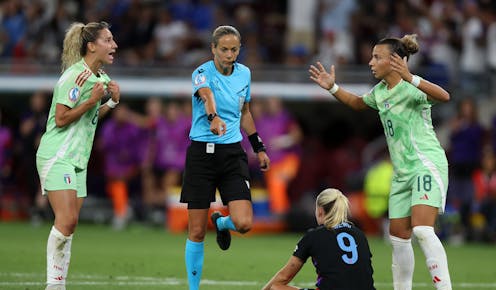Game changer: how data science is revolutionising athlete performance
Marco Iacobucci Epp/Shutterstock
Sports coaches have always made decisions based on experience, observation and intuition. But they are increasingly relying on hard evidence. Behind the scenes, a quiet revolution is transforming sport – driven not by human skills but by data.
Wearable sensors, video trackers, GPS and health monitors now capture almost everything an athlete does. From their speed and movement to heart rate and positioning, countless data are being recorded.
But how best apply all that data?
I work at the intersection of sports, statistics and artificial intelligence, leading the Modelling, Interdisciplinary, Data, Applied, Statistics (Midas) research team at the University of Luxembourg. Our goal is simple: use data to help athletes and coaches make better decisions.
Whether that’s adjusting tactics pre-match, predicting outcomes or preventing injury, data science is changing the game.
The challenge is to make sense of this plethora of data, which comes from different sources and is of different types. And that is precisely where statistical modelling and machine learning come into play.
By finding patterns in the data – such as why a certain (over-)training has led to reduced performance or even injury, for example – we can provide actionable insights. Indeed, these insights don’t just reveal or explain what has happened, but can also predict what is going to happen – and most importantly why.
To be able to predict as accurately as possible future performances and results and to estimate the risk of injuries, we’ve developed a new approach called statistically enhanced learning (SEL) — a framework that blends statistical modelling with machine learning.
In short, statistical insights can be transformed into features that help predictive algorithms work better. Consider “team strength”. This is an abstract concept we’ve come up with to represent the team’s current playing ability. And we model it out of data from the games teams have previously played.
It isn’t meaningful to use all individual games as input to a predictive algorithm. So we first build a statistical model to estimate team strengths from all these matches (giving more weight to more recent matches), and the estimated team strengths will then be used as input for the predictive algorithm.
Think of it as giving AI smarter inputs, such that it makes smarter predictions. In our studies, this approach consistently improves accuracy and interpretability across different sports.
Working with the Metz women’s handball team, champions of France in 2025, we developed prediction models that achieved over 80% accuracy. In a recent scientific paper, we combine game information (such as day of the week the game takes place, importance of the game) and team’s structure (height, weight, age of players) with the team strengths (which we estimate based on several previous match results) and feed all this into the programme. Without the team strengths, the accuracy would drop by roughly 20%.
Crucially, these models are not black boxes. We use explainable AI techniques so coaches can understand which variables drive the predictions, helping them adjust strategy and prepare more effectively.
Preventing injuries
Another key area is injury prevention. Injuries can derail a season, or even a career. By analysing patterns in performance and workload data, we can identify early warning signs. For example, slight declines in speed, jump height or reaction time may signal that a player is at risk.
Once flagged, coaches and medical staff can step in by adjusting training, adding rest days or tailoring recovery. Instead of reacting after an injury, teams can act proactively to keep athletes healthy.
Clearly our tools do not replace coaches. Rather they enhance their decision-making, be it at the level of tactical preparation or training setup. By turning data into insight, we help teams compete smarter.
Challenges and the future
Of course, this new era brings challenges. Data quality is not always consistent. Not all clubs can afford the same technology. And ethical questions arise around data ownership and athlete privacy. But the direction of travel is clear. Data science is becoming an essential part of sport, not just for top clubs and national teams, but across all levels.
We are also expanding our collaborations. This approach can be used in various sports including football, basketball and rugby. Our aim is to make analytics more accessible, explainable and useful, so that athletes and coaches, not just data scientists, benefit from what we learn.
As fans, we see the goals, the saves, the rallies, the celebrations. What we do not see is the science behind the scenes – the models predicting outcomes, the algorithms flagging risks, the data informing every sprint and substitution.
Sport will always be about passion, talent and human drama. But increasingly, it is also about probability, precision and the quiet power of data. And that might just be one of the most important game changers of all.
Christophe Ley is co-founder of the company GrewIA and President of the Luxembourg Statistical Society.



